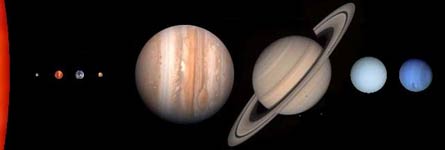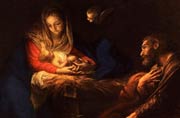The turning points
The Year 0
These annual calendars only give us an approximate indication and
method for comparison for determining our actual year, with differences
of up to 16 years in relation to the year zero. For the Christian churches
that established our calendar, two dates were and are important fixed
points for their calculation of the year, the creation of the world and
the birth of Christ. Crucial for any further comparison is the best possible
estimate for the year 0, because only then can we isolate where the years
2000 and 2012 really fit into our present calendar. Therefore, it is
important to establish which calendar to use as a basis of calculation,
which is where the controversies start.
The creation of the World Years
Although the Church’s calculations of the origin of the world do not
a hold up in the scientific community (which has dated the earliest
stage of the world to the Hadean, approximately 4.7 to 3.8 billion
years BC) and they are not relevant for determining the year 0, it
is interesting and amusing nonetheless to examine them in brief.
The Birth of Jesus Christ
The details already vary greatly in the gospels of the apostles of
the New Testament – those who would have known best:
Matthew (Matthew 2:1) says that Jesus was born before the death
of Herod the Great (who died 4 BC) and Luke (Luke 2.2) says that
Jesus was born during the first Roman census under Publius
Sulpicius Quirinius (governor of Judea starting in 6 AD) – already
a difference of 10 years. Because Quirinius deposed the subsequent
and incapable governor, Herod Archelaus, this is more likely and
almost completely agrees with the New Testament (census under
Quirinius, and later Herod Archelaus’ command to kill the newborns,
which, after a series of events led to his dismissal – because he had
not acted on a Roman command but rather out of his own
fear and greed).
Other sources
Interesting at this juncture is an interview with Peter Habison,
Director of Vienna Observatory (on December 24, 2008 with
Radio DRS 1, Switzerland), with the title “Star of Bethlehem”.
His conclusion from the Gospels, calendars and chronologies is:
- The astrologer Johannes Kepler discovered a supernova and
thought it was the trigger for the conjunction of the star of
Bethlehem, and then he found such a conjunction in the
constellation Pisces in 7 BC. His conclusion was that a
supernova (star) had also emerged. Meanwhile, however,
the supernova was disproven, and yet it is still evidence that
there was a stellar appearance around the time of Christ’s birth.
- The Gospels of Matthew and Luke place the birth of Christ around
the same time as the lifetime of Herod the Great, but according
to Roman tradition, he died in 4 BC.
The Year 0 in calendar calculations
Because it is not possible to accurately date predicted events,
the crucial question arises: when was the year 0?
The churches have been responsible for this until now and much
was improvised, as we have just seen with the creation year
of the world.
Determination of the beginning of the calendar
“In 525 AD, using clues in the Old Testament and the New Testament,
the Roman-Christian monk, Dionysius Exiguus, determined the birth
year of Jesus to be 754 after urbe condita (since the founding of Rome).
The Anno Domini dating system was devised in 525 by Dionysius Exiguus,
who used it to compute the date of the Christian Easter festival, and to
identify the several Easters in his Easter table, but did not use it to date
any historical event. (…) He designated the first year of Christ’s life with
one. The birth date and year of Jesus of Nazareth, however, were no
longer known to the subsequent Gentile Christians and were not recorded
by the contemporary and subsequent Jewish Christians.
Information differs in the gospels of the New Testament, which emerged
only generations later. According to Matthew 2:1 and Matthew 2:16,
King Herod the Great was alive when Jesus was born, and ordered the
Massacre of the Innocents in response to his birth. (…)
The Gospel of Luke states that Jesus was conceived during the reign of
Herod the Great (i.e., before 4 BC) while also stating that Jesus was born
when Cyrenius (or Quirinius) was the governor of Syria and carried out
the census of the Roman provinces of Syria and Iudaea. (…)
He first became the Governor of Judea, however, in 6 AD. Accordingly,
Jesus would have been born in the seventh year 7 according to our
current dating system. (…)
The Christian calendar is based, therefore, on uncertain assumptions
with regard to the equation of year one with the birth of Jesus Christ.”
(Wikipedia)
Yet another year of difference results from the use of 0 for the first year.
“Year zero” does not exist in the widely used Gregorian calendar or in
its predecessor, the Julian calendar. Under those systems, the year
1 BC is followed by AD 1. (…)
The absence of a year 0 leads to some confusion concerning the
boundaries of longer decimal intervals, such as decades and centuries. (…)
This rule results from the fact that the Gregorian calendar begins with a
year 1 instead of 0. Cardinal and ordinal numbering of years is therefore
identical: The year 10 is the tenth year of the calendar and the end of the
first decade. The year 11 is the first year of the second decade, and so on.
In spite of this rule, years ending in 0, rather than 1, are commonly
perceived as marking the beginning of a new decade, century,
or millennium. (…)
The Anno Domini era was introduced in 525 by Dionysius Exiguus
(c.470– c.544), who used it to identify the years on his Easter table. (…)
Dionysius did not use AD years to date any historical event. (…)
(Dionysius did not state the exact time of birth. For his Easter tables he
only equated specific years of the Roman calendar (with January 1 as
the beginning of the year) with an alternative count of the years after
Christ’s birth using the year anni ab incarnatione Domini, Latin for
“years after the incarnation of the Lord”.) Historians have never
included a year zero. This means that between, for example,
January 1, 500 BC and January 1, AD 500, there are 999 years:
500 years BC, and 499 years AD preceding 500.
In common usage anno Domini 1 is preceded by the year 1 BC,
without an intervening year zero. (…)
To simplify calculations, astronomers have used a defined leap year zero
equal to 1 BC of the traditional Christian era since the 17th century.”
(Wikipedia)
Seen from today’s calendar, we have to realize that we are about
7 years ahead of the year 0 due to dating errors, calculation errors,
shifts and corrections, which we must account for accordingly.
According to the information I have presented (from the calendars,
dating method for the year 0, history, gospels, science), the most
likely year of Jesus’ birth is 6 AD of the Gregorian calendar.
This also means that the actual year 2000 was our 2006 and 2012,
therefore, will be our 2018.
If we use this method of calculation, we have a few years yet before
the prophesied events of 2012 could take place. This results in a time
frame of approximately 20 years as one end of the running cycle
(our 1998 to 2018) and an additional 20 years before the actual turning
point (our 2018 to 2038). As already mentioned in the cycles, it is not true
that turning points and their effects will take place all at once or on a
single day, but slowly and starting in advance so that the energetic
transition can occur smoothly. There are processes for and developments
in consciousness and certain qualities that are brought about through
vibrations and resonance and they are always in wave form.
Therefore, we should not be fixed on dates but on a time period.
In addition, we should concentrate on our own internal changes,
not just on outward manifestations and changes in this “crazy world”.
The Year 2000
The topic of the year 2000 has three defining aspects:
the purely mathematical aspect of dating, dating in computer systems
and the almost simultaneous change in the cyclical calendars (linked
with the “doomsday scenarios”, especially from the Apocalypse of
John and a special star constellation). In terms of dating, we have already
shed light on the year 0 and came to the conclusion that the actual year
2000 may be our year 2006.
(Note to the curious:
What happened in 2006? The year was marked by worldwide escalations
of war, newly erupted famines and the massive accumulation of
environmental disasters – three typhoons, four tropical storms and
the tsunami in Indonesia. And according to spiritual sources it was
a pivotal year in which everything moved and opened, which is why
some people see 2006 as the year 2012).
I believe, therefore, that the calendar year 2000 must be considered
separately, i.e. as a mathematically fixed point to adjust our calendar,
rather than year when something actually happens.
The computer problem
Thus we come to the problem of dating in computers, which did not
actually have anything to do with the date itself, but rather the
mathematical counting method using zeros in computer systems
with regard to programming the last two digits of the year.
The problem was caused by the practice of using just two digits instead
for four to indicate years. This was associated worldwide with the
prophesied millennium change, although there is no connection from
my perspective.
Above all, religious and esoteric groups reacted surprisingly strongly
and openly to this special 99/2000 millennium shift. Information
circulated publicly in the various circles, from doomsday (followers of
the Bible), the Last Judgement (especially Jehovah’s Witnesses) and major
disasters at the turning point (new age), to enlightenment of the
world (new age), and evacuations of humans by aliens (ufologists and
blind admirers of “alien” dark beings).
But – whether true or false – none of this could happen from a
factual point of view because on the one hand, our calendar dates
have inaccurately shifted, and on the other hand, all the aspects of
these big changes do not actually occur with the year 2000 of our
annual calendar, but rather with the transition of the cyclical calendars
in the year 2012.
Planetary alignment in May 2000
All eight planets of our solar system were more or less in a horizontal
line to the center of the sun in May of 2000.
This was also interpreted as a sign of the coming apocalypse by both
religious and new age circles.

The Year 2012
The topic of the year 2012 also has four key aspects: the purely
mathematical aspect of dating, the coincidence of the cyclical calendars
in their expirations with regard to a new beginning, the coincidence
with the galactic alignment, and the many legends and prophecies about
a great change in human consciousness (which are usually associated with
the turn of the millennium and the year 2012). Precisely defining the year
0 as the birth of Jesus Christ in the year 6 AD of our Gregorian calendar
makes correlating the cyclical calendars much more accurate.
They are remarkably consistent as to the end of 2012, which is actually
2018 according to our Gregorian calendar. In this legendary year the
different cyclical calendars, legends and scenarios will coincide with
their end and a new beginning.
This is an excerpt from the book DEI LEGACY.

